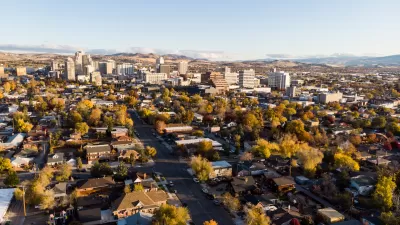In this era of increased inequality, socially-blind urban planning is morally questionable. Specifically, on the issue of homelessness in America, there are three problems to which planners need to pay particular attention.

The contrast between prosperity and poverty is most dramatic in the harshness of inclement weather. In San Diego this past weekend, while the storms resulting from El Nino lashed at the city, I drove through East Village, a neighborhood that contains one of the largest concentrations of homeless in the region. It is also the epicenter of Downtown’s new construction boom.
Amidst the broken tree branches and debris, scattered and soaked in the storm water were large black trash bags that homeless people had used to protect themselves. I saw helplessness in the eyes of an elderly couple as the rain whipped at them from every direction, drenching their belongings. An orderly line of about a half dozen people waited on the sidewalk for their turn to use the portable bathrooms, seemingly numb to the pouring rain. A series of blue tents clustered under the freeway bridge, sharing a tarp, and a young woman was braving the gusty winds to stand at that intersection, her hands clenching a soaked cardboard sign that simply read, “Homeless, Hungry.”
In the background, I saw construction cranes idling in the sky above them, poised to continue building a teal-colored luxury condominium tower with yellow and white accents.
America’s Finest City has an ugly problem.
The homeless population in San Diego is among the four largest in the nation and getting worse, with over 8,700 people living without shelter. And while this kind of weather is rare in San Diego, it is not new, yet even after anticipating the storm for months and knowing the severity of our homelessness problem, there was marginal galvanization of resources by local government. Simultaneously, the city was able to commit hundreds of millions of dollars in public funds for supporting downtown development with an expanded convention center and a Chargers stadium that the NFL does not want, all of which will likely be built in the very neighborhood these people call home.
In this era of increased inequality, socially-blind urban planning is morally questionable. Specifically, on the issue of homelessness in America, there are three problems that planners need to pay attention to:
Social impacts of planning are relegated to the margins. Planners often consider development projects from the sterile perspective of social value-free growth. Social issues such as homelessness appear as ancillary considerations, footnoted, or completely omitted in normal project planning and permitting processes. Social issues such as homelessness appear as ancillary considerations, footnoted, or completely omitted in normal project planning and permitting processes. I have served almost three years as a board member of San Diego’s downtown planning and permitting agency, yet not once has the issue of displacement been addressed by the agency when approving an unsubsidized housing project. Not once has a “vacant lot” that was at the time housing homeless people been treated as anything but developable dirt. Most developers proposing luxury housing projects in downtown get away providing no inclusionary housing and mandatory minimum fees. And there is a concerted effort in the street-front design of these towers to ensure that the homeless cannot sit, sleep or stay in the area.
FULL STORY: Socially-Blind Urban Planning

Alabama: Trump Terminates Settlements for Black Communities Harmed By Raw Sewage
Trump deemed the landmark civil rights agreement “illegal DEI and environmental justice policy.”

Planetizen Federal Action Tracker
A weekly monitor of how Trump’s orders and actions are impacting planners and planning in America.

Why Should We Subsidize Public Transportation?
Many public transit agencies face financial stress due to rising costs, declining fare revenue, and declining subsidies. Transit advocates must provide a strong business case for increasing public transit funding.

Understanding Road Diets
An explainer from Momentum highlights the advantages of reducing vehicle lanes in favor of more bike, transit, and pedestrian infrastructure.

New California Law Regulates Warehouse Pollution
A new law tightens building and emissions regulations for large distribution warehouses to mitigate air pollution and traffic in surrounding communities.

Phoenix Announces Opening Date for Light Rail Extension
The South Central extension will connect South Phoenix to downtown and other major hubs starting on June 7.
Urban Design for Planners 1: Software Tools
This six-course series explores essential urban design concepts using open source software and equips planners with the tools they need to participate fully in the urban design process.
Planning for Universal Design
Learn the tools for implementing Universal Design in planning regulations.
Caltrans
Smith Gee Studio
Institute for Housing and Urban Development Studies (IHS)
City of Grandview
Harvard GSD Executive Education
Toledo-Lucas County Plan Commissions
Salt Lake City
NYU Wagner Graduate School of Public Service




























